In multi-GPU computers running Windows 10, you can manually specify which graphics card a Windows app should use as default to either improve performance or increase battery efficiency. So today, we will show you how to set default GPU for apps in multi-GPU Windows 10 computers.
Set Default GPU for Apps in Windows 10
Generally, the integrated GPU (IGPU) is more power efficient, while the discrete GPU is better for demanding games and graphics-heavy applications. So if you’re looking to maximize performance without compromising on power efficiency, you’ve come to the right place. That’s because in this tutorial, we’ll show you how to set a preferred GPU for specific apps in Windows 10.
- Press Windows key+I simultaneously to open your PC Settings. Now click on ‘System’.
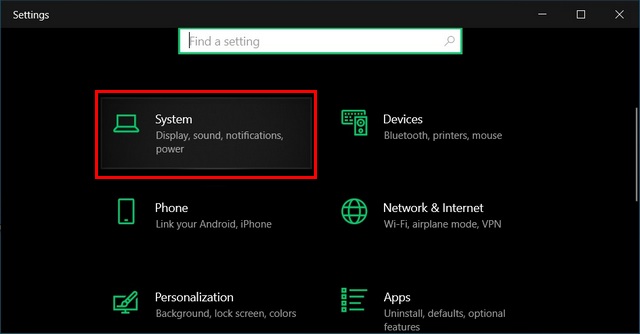
- Next, click on ‘Display’ on the left pane and select ‘Graphics settings’ on the right side.
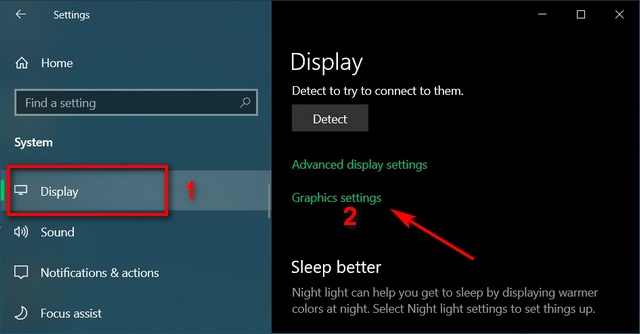
- From the drop-down menu, select whether you want to specify settings for desktop (classic) apps or Microsoft Store apps. For desktop apps, you’ll have to click on the ‘Browse’ button to manually specify the executable file of that app.
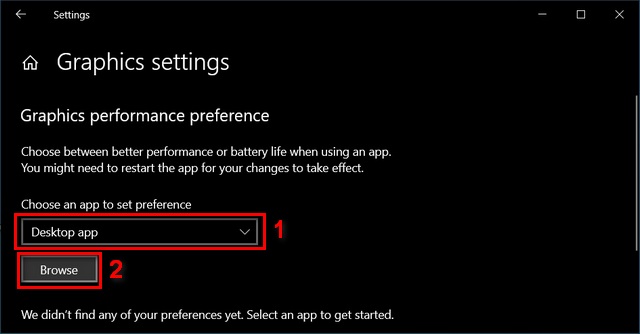
- Navigate to the program’s installation directory. Now select the .exe file for that application and click on ‘Add’.

Note: The default installation directory for 64-bit applications in Windows 10 is C:Program Files, while the default for 32-bit applications is C:Program Files (x86).
Before we tell you how you can set or change the default graphics card in Windows 10, here’s how you can select a Microsoft Store app:
- From the drop-down menu in step 3, select ‘Microsoft Store App’ instead of ‘Classic/Desktop app’. You’ll immediately get a second drop-down menu.

- From the second drop-down menu, select the app that you’re trying to set the GPU preference for.
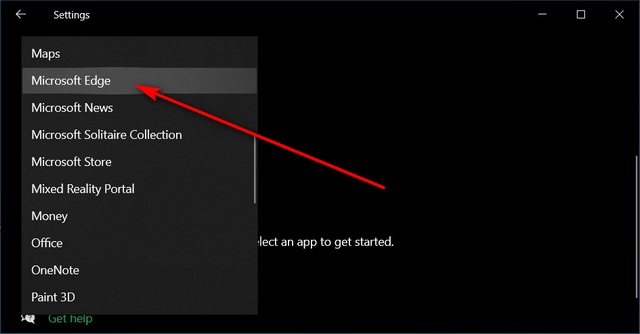
- Once you’ve selected the app, click on ‘Add’.

- Once you’ve added the app, click on the ‘Options’ button in the box that appears.
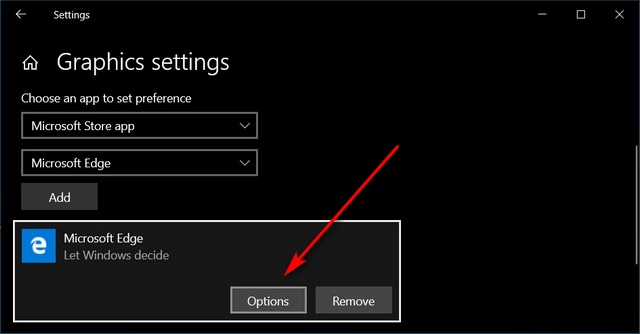
- You’ll get three options for the preferred GPU:
- Let Windows Decide
- Power Saving (typically the integrated GPU)
- High Performance (typically the discrete GPU)
Choose the option you want and remember to click on the ‘Save’ button once you’ve taken your pick.
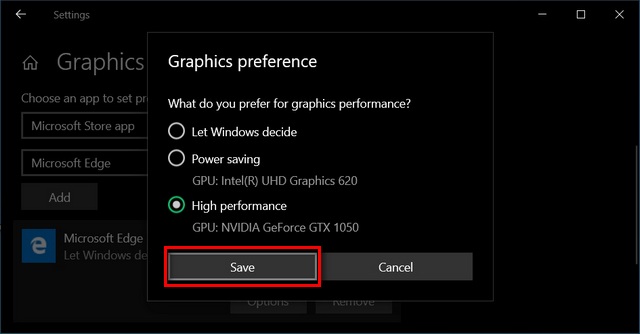
That’s it. You have now successfully specified which GPU your Windows 10 computer should use for a particular app. Restart your PC for the changes to take effect.
List of Popular GPUs
The method described below works for all modern graphics processors, so you can use it to set your preferred Nvidia or AMD card as default for any app in Windows 10. We have mentioned a list of popular GPUs below. Note that this is not an exhaustive list and is here to only serve as an example.
| Graphics Card Names | CUDA Cores / Stream processors | Game Clock / Boost Clock | VRAM | TDP | Architecture | GPU | Manufacturing Process |
|---|---|---|---|---|---|---|---|
| AMD Radeon RX 6900 XT | 80 | Up to 2250 MHz | 16GB | 300 W | RDNA 2.0 | Navi 21 | 7 nm |
| AMD Radeon RX 6800 XT | 72 | Up to 2250 MHz | 16GB | 300 W | RDNA 2.0 | Navi 21 | 7 nm |
| AMD Radeon RX 6800 | 60 | Up to 2105 MHz | 16GB | 250 W | RDNA 2.0 | Navi 21 | 7 nm |
| AMD Radeon RX 5700 XT 50th Anniversary | 40 | Up to 1980 MHz | 8GB | 235 W | RDNA 1.0 | Navi 10 | 7 nm |
| AMD Radeon RX 5700 XT | 40 | Up to 1905 MHz | 8GB | 225 W | RDNA 1.0 | Navi 10 | 7 nm |
| AMD Radeon VII | 60 | Up to 1750 MHz | 16GB | 300 W | GCN 5.1 | Vega 20 | 7 nm |
| AMD Radeon RX 5700 | 36 | Up to 1725 MHz | 8GB | 180 W | RDNA 1.0 | Navi 10 | 7 nm |
| AMD Radeon RX 5600 XT | 36 | Up to 1560 MHz | 6GB | 150 W | RDNA 1.0 | Navi 10 | 7 nm |
| AMD Radeon RX 5600 | 32 | Up to 1560 MHz | 6GB | 150 W | RDNA 1.0 | Navi 10 | 7 nm |
| AMD Radeon RX 5500 XT | 22 | Up to 1845 MHz | 8GB | 130 W | RDNA 1.0 | Navi 14 | 7 nm |
| AMD Radeon RX 5700M | 36 | Up to 1720 MHz | 8GB | 180 W | RDNA 1.0 | Navi 10 | 7 nm |
| AMD Radeon RX 5600M | 36 | Up to 1265 MHz | 6GB | 150 W | RDNA 1.0 | Navi 10 | 7 nm |
| AMD Radeon RX 5500 | 22 | Up to 1845 MHz | 4GB | 150 W | RDNA 1.0 | Navi 14 | 7 nm |
| AMD Radeon RX 5300 | 22 | Up to 1645 MHz | 3GB | 100 W | RDNA 1.0 | Navi 14 | 7 nm |
| AMD Radeon RX 5500M | 22 | Up to 1645 MHz | 4GB | 85 W | RDNA 1.0 | Navi 14 | 7 nm |
| Radeon RX Vega 64 Liquid Cooled | 64 | Up to 1677 MHz | 8GB | 345 W | GCN 5.0 | Vega 10 | 14 nm |
| AMD Radeon RX 5300M | 22 | Up to 1445 MHz | 3GB | 85 W | RDNA 1.0 | Navi 14 | 7 nm |
| Radeon RX Vega 64 | 64 | Up to 1546 MHz | 8GB | 295 W | GCN 5.0 | Vega 10 | 14 nm |
| Radeon RX Vega 56 | 56 | Up to 1471 MHz | 8GB | 210 W | GCN 5.0 | Vega 10 | 14 nm |
| Radeon RX 590 | 36 | Up to 1545 MHz | 8GB | 175 W | GCN 4.0 | Polaris 30 | 12 nm |
| Radeon RX 580 | 36 | Up to 1340 MHz | 8GB | 185 W | GCN 4.0 | Polaris 20 | 14 nm |
| Radeon RX 580 (OEM) | 36 | 1266-1340 MHz | 8GB | 185 W | GCN 4.0 | Ellesmere | 14 nm |
| Radeon RX 640 | 8/ 10 | Up to 1287 MHz | 4GB | 50 W | GCN 4.0 | Polaris 23 | 14 nm |
| Radeon RX 580X | 36 | Up to 1340 MHz | 8GB | 185 W | GCN 4.0 | Polaris 20 | 14 nm |
| Radeon RX 570 | 32 | Up to 1244 MHz | 8GB | 150 W | GCN 4.0 | Polaris 20 | 14 nm |
| Radeon RX 570 (OEM) | 1206-1244 MHz | 8GB | 150 W | GCN 4.0 | Polaris 20 | 14 nm | |
| Radeon 630 | 8 | Up to 1219 MHz | 4GB | 50 W | GCN 4.0 | Polaris 23 | 14 nm |
| Radeon RX 570X | 32 | Up to 1244 MHz | 8GB | 150 W | GCN 4.0 | Polaris 20 | 14 nm |
| Radeon RX 560 (OEM) | 14/16 | 1200-1275 MHz | 4GB | 60-80 W | GCN 4.0 | Polaris 21 | 14 nm |
| Radeon 625 | 6 | Up to 1024 MHz | 4GB | 50 W | GCN 3.0 | Polaris 24 | 28 nm |
| Radeon RX 560 | 14/16 | Up to 1275 MHz | 4GB | 60-80 W | GCN 4.0 | Polaris 21 | 14 nm |
| Radeon RX 560X | 14/16 | Up to 1275 MHz | 4GB | 75 W | GCN 4.0 | Polaris 21 | 14 nm |
| Radeon 620 | 6 | Up to 1024 MHz | 4GB | 50 W | GCN 3.0 | Polaris 24 | 28 nm |
| Radeon RX 550 | Up to 1183 MHz | 4GB | 50 W | GCN 4.0 | Lexa | 14 nm | |
| Radeon RX 550X | 8/ 10 | Up to 1287 MHz | 4GB | 50 W | GCN 4.0 | Lexa | 14 nm |
| Radeon RX 540 | 8 | Up to 1219 MHz | 4GB | 50 W | GCN 4.0 | Lexa | 14 nm |
| Radeon 610 | 5 | Up to 1030 MHz | 4GB | 50 W | GCN 1.0 | Banks | 28 nm |
| Radeon RX 540X | 8 | Up to 1219 MHz | 4GB | 50 W | GCN 4.0 | Polaris 23 | 14 nm |
| Radeon 550X | 08/10/2021 | Up to 1287 MHz | 4GB | 50 W | GCN 4.0 | Lexa | 14 nm |
| Radeon 540 | 8 | Up to 1124 MHz | 4GB | 50 W | GCN 4.0 | Lexa | 14 nm |
| Radeon 540X | 8 | Up to 1219 MHz | 4GB | 50 W | GCN 4.0 | Lexa | 14 nm |
| Radeon 535 | 6 | Up to 1024 MHz | 4GB | 50 W | GCN 3.0 | Polaris 24 | 28 nm |
| Radeon 530 | 6 | Up to 1024 MHz | 4GB | 50 W | GCN 3.0 | Weston | 28 nm |
| Radeon 520 | 5 | Up to 1030 MHz | 4GB | 50 W | GCN 1.0 | Banks | 28 nm |
| AMD Radeon RX 480 | 36 | Up to 1266 MHz | 4GB | 150 W | GCN 4.0 | Ellesmere | 14 nm |
| Radeon RX 470 | 32 | Up to 1206 MHz | 4GB | 120 W | GCN 4.0 | Ellesmere | 14 nm |
| Radeon RX 460 | 14 | Up to 1200 MHz | 2GB | 70 W | GCN 4.0 | Baffin | 14 nm |
| GeForce GT 1010 | 256 | 1253 MHz | 2 GB | 30 W | Pascal | GP108 | 14 nm |
| GeForce RTX 3050 | 2304 | 1750 MHz | 4 GB | 90 W | Ampere | GA107 | 8 nm |
| GeForce RTX 3060 | 3584 | 1875 MHz | 12 GB | 170 W | Ampere | GA106 | 8 nm |
| GeForce RTX 3060 Max-Q | 3072 | 1375 MHz | 6 GB | 60 W | Ampere | GA106 | 8 nm |
| GeForce RTX 3060 Mobile | 3072 | 1750 MHz | 6 GB | 80 W | Ampere | GA106 | 8 nm |
| GeForce RTX 3070 Max-Q | 5120 | 1250 MHz | 8 GB | 80 W | Ampere | GA104 | 8 nm |
| GeForce RTX 3070 Mobile | 5120 | 1500 MHz | 8 GB | 115 W | Ampere | GA104 | 8 nm |
| GeForce RTX 3070 Ti | 7424 | 1188 MHz | 10 GB | 200 W | Ampere | GA103 | 8 nm |
| GeForce RTX 3080 Max-Q | 6144 | 1500 MHz | 8 GB | 80 W | Ampere | GA104 | 8 nm |
| GeForce RTX 3080 Mobile | 6144 | 1500 MHz | 8 GB | 115 W | Ampere | GA104 | 8 nm |
| GeForce RTX 3080 Ti | 10496 | 1219 MHz | 20 GB | 350 W | Ampere | GA102 | 8 nm |
| RTX A40 | 10752 | 1812 MHz | 48 GB | 300 W | Ampere | GA102 | 8 nm |
| RTX A4000 | 6144 | 2000 MHz | 16 GB | 150 W | Ampere | GA104 | 8 nm |
| RTX A5000 | 8192 | 2000 MHz | 24 GB | 230 W | Ampere | GA103 | 8 nm |
| GeForce GT 1010 | 256 | 1253 MHz | 2 GB | 30 W | Pascal | GP108 | 14 nm |
| GeForce GTX 1650 TU116 | 896 | 1500 MHz | 4 GB | 80 W | Turing | TU116 | 12 nm |
| GeForce GTX 1650 TU106 | 896 | 1500 MHz | 4 GB | 90 W | Turing | TU106 | 12 nm |
| GeForce GTX 1650 Ti Mobile | 1024 | 1500 MHz | 4 GB | 50 W | Turing | TU116 | 12 nm |
| GeForce GTX 1650 Mobile | 1024 | 1500 MHz | 4 GB | 50 W | Turing | TU117 | 12 nm |
| GeForce GTX 1650 Max-Q | 1024 | 1250 MHz | 4 GB | 30 W | Turing | TU117 | 12 nm |
| GeForce GTX 1650 Ti Max-Q | 1024 | 1250 MHz | 4 GB | 50 W | Turing | TU117 | 12 nm |
| GeForce GTX 1650 Ti Mobile | 1024 | 1500 MHz | 4 GB | 50 W | Turing | TU117 | 12 nm |
| GeForce GTX 1650 6 | 896 | 1500 MHz | 4 GB | 75 W | Turing | TU117 | 12 nm |
| GeForce GTX 1650 SUPER | 1280 | 1500 MHz | 4 GB | 100 W | Turing | TU116 | 12 nm |
| GeForce GTX 1660 SUPER | 1408 | 1750 MHz | 6 GB | 125 W | Turing | TU116 | 12 nm |
| GeForce GTX 1650 Max-Q | 1024 | 1751 MHz | 4 GB | 30 W | Turing | TU117 | 12 nm |
| GeForce GTX 1660 Ti Max-Q | 1536 | 1500 MHz | 6 GB | 60 W | Turing | TU116 | 12 nm |
| GeForce GTX 1660 Ti Mobile | 1536 | 1500 MHz | 6 GB | 80 W | Turing | TU116 | 12 nm |
| GeForce GTX 1650 Mobile | 1024 | 2001 MHz | 4 GB | 50 W | Turing | TU117 | 12 nm |
| GeForce GTX 1650 | 896 | 2001 MHz | 4 GB | 75 W | Turing | TU117 | 12 nm |
| GeForce GTX 1660 | 1408 | 2001 MHz | 6 GB | 120 W | Turing | TU116 | 12 nm |
| GeForce GTX 1660 Ti | 1536 | 1500 MHz | 6 GB | 120 W | Turing | TU116 | 12 nm |
| GeForce GTX 1050 Mobile 3 GB | 768 | 1752 MHz | 3 GB | 75 W | Pascal | GP107 | 14 nm |
| GeForce GTX 1060 8 GB 5X | 1280 | 1001 MHz | 8 GB | 120 W | Pascal | GP104 | 16 nm |
| GeForce GTX 1060 6 GB 5X | 1280 | 1001 MHz | 6 GB | 120 W | Pascal | GP104 | 16 nm |
| GeForce GT 1030 GK107 | 384 | 1250 MHz | 2 GB | 65 W | Kepler | GK107 | 28 nm |
| GeForce GTX 1080 Ti 10 GB | 3200 | 1376 MHz | 10 GB | 250 W | Pascal | GP102 | 16 nm |
| GeForce GTX 1050 3 GB | 768 | 1752 MHz | 3 GB | 75 W | Pascal | GP107 | 14 nm |
| GeForce GT 1030 DDR4 | 384 | 1050 MHz | 2 GB | 20 W | Pascal | GP108 | 14 nm |
| GeForce GTX 1060 6 GB GP104 | 1280 | 2002 MHz | 6 GB | 120 W | Pascal | GP104 | 16 nm |
| GeForce GTX 1060 6 GB Rev. 2 | 1280 | 2002 MHz | 6 GB | 120 W | Pascal | GP106 | 16 nm |
| GeForce GTX 1050 Ti Max-Q | 768 | 1752 MHz | 4 GB | 75 W | Pascal | GP107 | 14 nm |
| GeForce GTX 1050 Max-Q | 640 | 1752 MHz | 4 GB | 75 W | Pascal | GP107 | 14 nm |
| GeForce GTX 1060 5 GB | 1280 | 2002 MHz | 5 GB | 120 W | Pascal | GP106 | 16 nm |
| GeForce GTX 1070 Ti | 2432 | 2002 MHz | 8 GB | 180 W | Pascal | GP104 | 16 nm |
| GeForce GT 720 OEM | 192 | 891 MHz | 1024 MB | 50 W | Kepler | GK107 | 28 nm |
| GeForce GTX 1060 Max-Q | 1280 | 2002 MHz | 6 GB | 80 W | Pascal | GP106 | 16 nm |
| GeForce GTX 1080 Max-Q | 2560 | 1251 MHz | 8 GB | 150 W | Pascal | GP104 | 16 nm |
| GeForce GTX 1070 Max-Q | 2048 | 2002 MHz | 8 GB | 115 W | Pascal | GP104 | 16 nm |
| GeForce GT 1030 | 384 | 1502 MHz | 2 GB | 30 W | Pascal | GP108 | 14 nm |
| GeForce GTX 1060 6 GB 9Gbps | 1280 | 2257 MHz | 6 GB | 120 W | Pascal | GP106 | 16 nm |
| GeForce GTX 1080 11Gbps | 2560 | 1376 MHz | 8 GB | 180 W | Pascal | GP104 | 16 nm |
| GeForce GTX 1080 Ti | 3584 | 1376 MHz | 11 GB | 250 W | Pascal | GP102 | 16 nm |
| GeForce GTX 1050 Ti Mobile | 768 | 1752 MHz | 2 GB | 75 W | Pascal | GP106 | 14 nm |
| GeForce GTX 1050 Mobile | 640 | 1752 MHz | 2 GB | 75 W | Pascal | GP107 | 14 nm |
| GeForce GTX 1060 3 GB GP104 | 1152 | 2002 MHz | 3 GB | 120 W | Pascal | GP104 | 16 nm |
| GeForce GTX 760 OEM | 1344 | 1650 MHz | 2 GB | 130 W | Kepler | GK104 | 28 nm |
| GeForce GTX 1050 Ti | 768 | 1752 MHz | 4 GB | 75 W | Pascal | GP107 | 14 nm |
| GeForce GTX 1050 | 640 | 1752 MHz | 2 GB | 75 W | Pascal | GP107 | 14 nm |
| GeForce GTX 1060 3 GB | 1152 | 2002 MHz | 3 GB | 120 W | Pascal | GP106 | 16 nm |
| GeForce GTX 1060 Mobile | 1280 | 2002 MHz | 6 GB | 80 W | Pascal | GP106 | 16 nm |
| RTX A5000 | 8192 | 2000 MHz | 24 GB | 230 W | Ampere | GA103 | 8 nm |
| GeForce RTX 3070 Ti | 7424 | 1188 MHz | 10 GB | 200 W | Ampere | GA103 | 8 nm |
| GeForce RTX 3080 Ti | 10496 | 1219 MHz | 20 GB | 350 W | Ampere | GA102 | 8 nm |
| RTX A4000 | 6144 | 2000 MHz | 16 GB | 150 W | Ampere | GA104 | 8 nm |
| RTX A40 | 10752 | 1812 MHz | 48 GB | 300 W | Ampere | GA102 | 8 nm |
| GeForce RTX 3050 | 2304 | 1750 MHz | 4 GB | 90 W | Ampere | GA107 | 8 nm |
| GeForce RTX 3060 Mobile | 3072 | 1750 MHz | 6 GB | 80 W | Ampere | GA106 | 8 nm |
| GeForce RTX 3080 Max-Q | 6144 | 1500 MHz | 8 GB | 80 W | Ampere | GA104 | 8 nm |
| GeForce RTX 3060 Max-Q | 3072 | 1375 MHz | 6 GB | 60 W | Ampere | GA106 | 8 nm |
| GeForce RTX 3070 Mobile | 5120 | 1500 MHz | 8 GB | 115 W | Ampere | GA104 | 8 nm |
| GeForce RTX 3070 Max-Q | 5120 | 1250 MHz | 8 GB | 80 W | Ampere | GA104 | 8 nm |
| GeForce RTX 3080 Mobile | 6144 | 1500 MHz | 8 GB | 115 W | Ampere | GA104 | 8 nm |
| GeForce RTX 3060 | 3584 | 1875 MHz | 12 GB | 170 W | Ampere | GA106 | 8 nm |
| GeForce RTX 3060 Ti | 4864 | 1750 MHz | 8 GB | 200 W | Ampere | GA104 | 8 nm |
| RTX A6000 | 10752 | 1750 MHz | 48 GB | 300 W | Ampere | GA102 | 8 nm |
| GeForce RTX 3070 | 5888 | 1750 MHz | 8 GB | 220 W | Ampere | GA104 | 8 nm |
| GeForce RTX 3090 | 10496 | 1219 MHz | 24 GB | 350 W | Ampere | GA102 | 8 nm |
| GeForce RTX 3080 | 8704 | 1188 MHz | 10 GB | 320 W | Ampere | GA102 | 8 nm |
| GRID RTX T10-16 | 4608 | 1575 MHz | 16 GB | 260 W | Turing | TU102 | 12 nm |
| GRID RTX T10-8 | 4608 | 1750 MHz | 8 GB | 260 W | Turing | TU102 | 12 nm |
| GRID RTX T10-4 | 4608 | 1750 MHz | 4 GB | 260 W | Turing | TU102 | 12 nm |
| Quadro RTX 6000 Mobile | 4608 | 1750 MHz | 24 GB | 260 W | Turing | TU102 | 12 nm |
| Quadro RTX 5000 Mobile Refresh | 3072 | 1750 MHz | 16 GB | 110 W | Turing | TU104B | 12 nm |
| GeForce RTX 2080 SUPER Max-Q | 3072 | 1375 MHz | 8 GB | 80 W | Turing | TU104 | 12 nm |
| GeForce RTX 2070 SUPER Max-Q | 2560 | 1375 MHz | 8 GB | 90 W | Turing | TU104 | 12 nm |
| GeForce RTX 2070 SUPER Mobile | 2560 | 1750 MHz | 8 GB | 115 W | Turing | TU104 | 12 nm |
| GeForce RTX 2080 SUPER Mobile | 3072 | 1750 MHz | 8 GB | 150 W | Turing | TU104 | 12 nm |
| GeForce RTX 2070 Max-Q Refresh | 2304 | 1375 MHz | 8 GB | 115 W | Turing | TU106B | 12 nm |
| GeForce RTX 2070 Mobile Refresh | 2304 | 1375 MHz | 8 GB | 115 W | Turing | TU106B | 12 nm |
| GeForce RTX 2060 Max-Q | 1920 | 1375 MHz | 6 GB | 65 W | Turing | TU106 | 12 nm |
| GeForce RTX 2060 TU104 | 1920 | 1750 MHz | 6 GB | 160 W | Turing | TU104 | 12 nm |
| GeForce RTX 2080 SUPER | 3072 | 1937 MHz | 8 GB | 250 W | Turing | TU104 | 12 nm |
| GeForce RTX 2060 SUPER | 2176 | 1750 MHz | 8 GB | 175 W | Turing | TU106 | 12 nm |
| GeForce RTX 2070 SUPER | 2560 | 1750 MHz | 8 GB | 215 W | Turing | TU104 | 12 nm |
| Quadro RTX 3000 Mobile Refresh | 1920 | 1750 MHz | 6 GB | 80 W | Turing | TU106 | 12 nm |
| Quadro RTX 5000 Max-Q | 3072 | 1750 MHz | 16 GB | 80 W | Turing | TU104 | 12 nm |
| Quadro RTX 5000 Mobile | 3072 | 1750 MHz | 16 GB | 110 W | Turing | TU104 | 12 nm |
| Quadro RTX 4000 Mobile | 2560 | 1750 MHz | 8 GB | 110 W | Turing | TU104 | 12 nm |
| Quadro RTX 3000 Max-Q | 1920 | 1500 MHz | 6 GB | 60 W | Turing | TU106 | 12 nm |
| Quadro RTX 3000 Mobile | 1920 | 1750 MHz | 6 GB | 80 W | Turing | TU106 | 12 nm |
| Quadro RTX 4000 Max-Q | 2560 | 1625 MHz | 8 GB | 80 W | Turing | TU104 | 12 nm |
| GeForce RTX 2060 Max-Q Refresh | 1920 | 1353 MHz | 6 GB | 115 W | Turing | TU106B | 12 nm |
| GeForce RTX 2060 Mobile Refresh | 1920 | 1375 MHz | 6 GB | 65 W | Turing | TU106B | 12 nm |
| GeForce RTX 2070 Max-Q | 2304 | 1500 MHz | 8 GB | 90 W | Turing | TU106 | 12 nm |
| GeForce RTX 2080 Max-Q | 2944 | 1500 MHz | 8 GB | 90 W | Turing | TU104 | 12 nm |
| GeForce RTX 2070 Mobile | 2304 | 1750 MHz | 8 GB | 115 W | Turing | TU106 | 12 nm |
| GeForce RTX 2060 Mobile | 1920 | 1750 MHz | 6 GB | 115 W | Turing | TU106 | 12 nm |
| GeForce RTX 2080 Mobile | 2944 | 1750 MHz | 8 GB | 150 W | Turing | TU104 | 12 nm |
| GeForce RTX 2060 | 1920 | 1750 MHz | 6 GB | 160 W | Turing | TU106 | 12 nm |
| TITAN RTX | 4608 | 1750 MHz | 24 GB | 280 W | Turing | TU102 | 12 nm |
Choose Your Preferred Graphics Processor for Apps on Your Computer
Using the method above, you can set your default graphics card preference (either Nvidia or AMD) for any number of apps in Windows 10. Starting with build 20190, Windows 10 is also letting users specify graphics cards on a per-application basis for even more granular control. It was rolled out late last year to Windows Insiders in the Dev channel, so if you are OK with the bugs and the potential instability, you can join the Windows Insider program by clicking through this link.
While we’re talking about extracting the best out of your Windows 10 PC in terms of both performance and efficiency, you can also check out our Windows 10 tips and tricks, how to use God Mode and how to use PowerToys on Windows 10 to get even better control of your computer. Also, don’t forget to check out the tools to stress test GPUs so you can check how your GPU stack against the competition.



![[2023] 6 façons de copier / coller du texte brut sans formatage](https://media.techtribune.net/uploads/2021/03/5-Ways-to-Copy-Paste-Plain-Text-Without-Formatting-on-Your-Computer-shutterstock-website-238x178.jpg)






